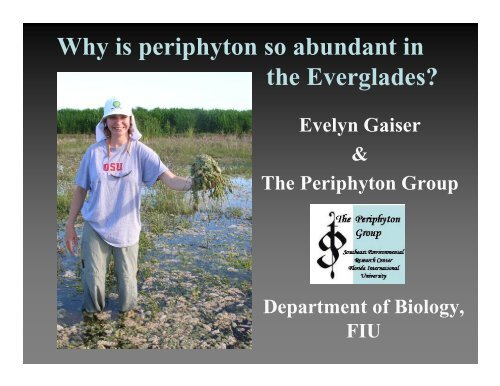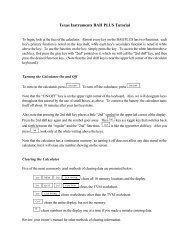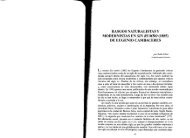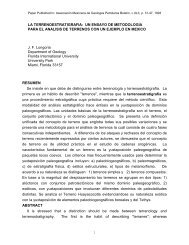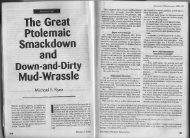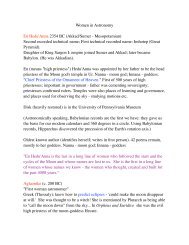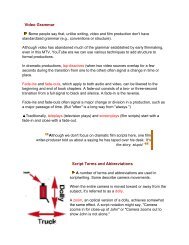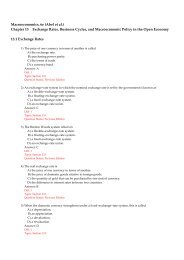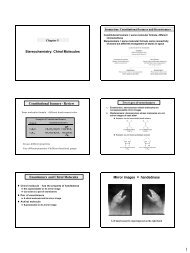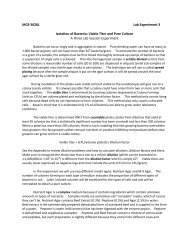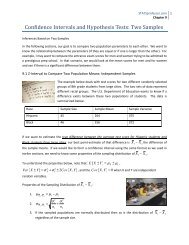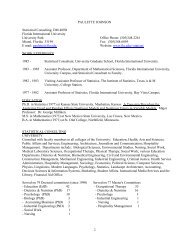Why is periphyton so abundant in the Everglades?
Why is periphyton so abundant in the Everglades?
Why is periphyton so abundant in the Everglades?
You also want an ePaper? Increase the reach of your titles
YUMPU automatically turns print PDFs into web optimized ePapers that Google loves.
<strong>Why</strong> <strong>is</strong> <strong>periphyton</strong> <strong>so</strong> <strong>abundant</strong> <strong>in</strong><strong>the</strong> <strong>Everglades</strong>?Evelyn Ga<strong>is</strong>er&The Periphyton GroupDepartment of Biology,FIU
Periphyton <strong>in</strong> <strong>the</strong> <strong>Everglades</strong>• Ubiquitous <strong>in</strong> natural areas• Grows on all benthic substrates• High productivity <strong>in</strong> low nutrient,high stress environmentTypesCompositionProductivity
Types of Periphyton CommunitiesMetaphytonEpiphytonEpilithon• Benthic <strong>periphyton</strong> communities are diverse– >80% of freshwater algae and cyanobacteria live attached tosubstrates• Species diversity l<strong>in</strong>ked to habitat heterogeneity• Benthic biomass exceeds planktonic biomass <strong>in</strong> wetlands– Nutrients are more available from substrates than <strong>in</strong> water– Large surface area for colonization– Nearby neighbors <strong>in</strong>crease efficiency of nutrient recycl<strong>in</strong>g
Composition of Periphyton Communities• Filamentouscyanobacteriadom<strong>in</strong>atebiovolume• Scytonemahofmanii andSchizothrixcalcicola dom<strong>in</strong>atebut 27 o<strong>the</strong>rfilamentous cyanoshave been foundPhotos by M. Gantar• Eubacteria areal<strong>so</strong> <strong>abundant</strong>
Composition of Periphyton Communities• Filamentous cyanos precipitateCaCO 3 <strong>in</strong> th<strong>is</strong> hardwaterenvironment• Calcite compr<strong>is</strong>es 20-90% of<strong>periphyton</strong> biomass, depend<strong>in</strong>gon hydrology10080% CalcitePhotos by M. Gantar60402000 4 8 12 16 24 48Hydroperiod (months)Dav<strong>is</strong>, Ga<strong>is</strong>er et al. In Press
Composition of Periphyton Communities• Coccoid cyanobacteria are al<strong>so</strong><strong>abundant</strong> (124 taxa catelogued)• These produce polysaccharideglue that holds <strong>the</strong> mat toge<strong>the</strong>rDonar, Gantar & Ga<strong>is</strong>er 2004
Composition of Periphyton Communities• Over 340freshwater and720 mar<strong>in</strong>ediatom taxacateloguedfrom S. Fla.<strong>periphyton</strong>*• Diatoms al<strong>so</strong>producecopious EPSPhotos by M. Gantar, A. Wachnicka*Images are posted athttp://serc.fiu.edu/<strong>periphyton</strong>
Productivity of Periphyton CommunitiesANPP by Site (g C m -2 yr -1 )SRSTransect6TS/PhTransect543211 101123 456 8796004002000100003000200010000SRS transect1 2 3 4 5 6TS transect1 2 3 4 5 6 7 8PeriphytonSawgrassMangrovesSeagrass9 10 11Periphyton dom<strong>in</strong>ates primary production <strong>in</strong> 8 of 17 sites <strong>in</strong> <strong>the</strong> FCE
Productivity of Periphyton CommunitiesGPP g C m -2 d -1<strong>Everglades</strong> (WCA2A)L. Okeechobee6.628.25McCormick et al. 1998Havens et al. 1999<strong>Everglades</strong> examples<strong>Everglades</strong> (WCA 2A)<strong>Everglades</strong> (ENP)6.980.99McCormick et al. 2001Browder et al. 1984Mean = 5 g C m -2 d -1<strong>Everglades</strong> (ENP)0.98Swift 1989<strong>Everglades</strong> (ENP, TS)3.81Ga<strong>is</strong>er et al. 2005FW Wetland, Belize7.27Rejmankova & Komarkova 2000L. Schultz Creek, ALLake Borax, CALawrence Lake, MILake Michigan, MI0.230.272.000.09Stock & Ward 1989Wetzel 1966Rich & Wetzel 1978Barko et al. 1977O<strong>the</strong>r <strong>periphyton</strong> examplesMean = 0.5 g C m -2 d -1Lake Marion, ON0.11Gruendl<strong>in</strong>g 1971Red Cedar River, MI0.28K<strong>in</strong>g and Ball 1966Hart's Run, KY0.26Kevern et al. 1966Salt marsh, TX0.19Hall et al., 1985Dupl<strong>in</strong> R. Marsh, GA0.41Pomeroy et al. 1981Lousiana Marsh, LA1.10Moncreiff 1983
Productivity of Periphyton CommunitiesBiomass of plants and <strong>periphyton</strong> <strong>in</strong> wet prairie sitesMacrophytes59 +/- 34 g DM m -2Periphyton228 +/-96 g AFDM m -2· Surveysites ofRoss &Ga<strong>is</strong>er
<strong>Why</strong> <strong>is</strong> <strong>periphyton</strong> <strong>so</strong> <strong>abundant</strong>???
Factors Influenc<strong>in</strong>g Periphyton AttributesWater Chem<strong>is</strong>try•Sal<strong>in</strong>ity•Nutrients•pH, CaCO 3Temperature•Range•Sea<strong>so</strong>nalityHydrology•Water depth•DurationPeriphyton•Structure•Composition•AbundanceLight•Intensity•Quality•PhotoperiodConsumer <strong>in</strong>teractionsFirePlant <strong>in</strong>teractions
Factors Influenc<strong>in</strong>g Periphyton AttributesWater Chem<strong>is</strong>try•Sal<strong>in</strong>ity•Nutrients•pH, CaCO 3Temperature•Range•Sea<strong>so</strong>nalityHydrology•Water depth•DurationPeriphyton•Structure•Composition•AbundanceLight•Intensity•Quality•PhotoperiodConsumer <strong>in</strong>teractionsFirePlant <strong>in</strong>teractions
Periphyton mats tolerate a broad sal<strong>in</strong>ity rangefrom marshes to mangroves to seagrass beds
Mats have similar appearance but differentcommunity composition
Strong sal<strong>in</strong>ity relationships allow reliablepredictionsModel: B<strong>is</strong>cayne Bay WetlandsModel: Florida BayDiatom-Predicted Sal<strong>in</strong>ity (ppt)302520151050R 2 = 0.91RMSE = 0.140 5 10 15 20 25 30Observed Sal<strong>in</strong>ity (ppt)Diatom-Predicted Sal<strong>in</strong>ity (ppt)4032241680R²=0.96RMSE = 2 ppt0 8 16 24 32 40Observed Sal<strong>in</strong>ity (ppt)
<strong>Why</strong> <strong>is</strong> <strong>periphyton</strong> <strong>so</strong> <strong>abundant</strong> <strong>in</strong> <strong>the</strong><strong>Everglades</strong>?• Sal<strong>in</strong>ity – similar <strong>periphyton</strong> mats ex<strong>is</strong>t across broad sal<strong>in</strong>ityrange with species swapp<strong>in</strong>g functional roles across spectrum
Factors Influenc<strong>in</strong>g Periphyton AttributesWater Chem<strong>is</strong>try•Sal<strong>in</strong>ity•Nutrients•pH, CaCO 3Temperature•Range•Sea<strong>so</strong>nalityHydrology•Water depth•DurationPeriphyton•Structure•Composition•AbundanceLight•Intensity•Quality•PhotoperiodConsumer <strong>in</strong>teractionsFirePlant <strong>in</strong>teractions
Sea<strong>so</strong>nality <strong>is</strong> cons<strong>is</strong>tent across sites0.140.12Periphyton Production (mean g C m -2 d -1 )FCE LTER SRS 1-3, TS 4-6, 9-112000-2004T = 17-32 ºC0.10.080.060.04Dry sea<strong>so</strong>n0.020J F M A M J J A S O N DMonth• Periphyton production <strong>is</strong> less sea<strong>so</strong>nally variable <strong>in</strong> subtropics than temperatewetlands• Peak biomass <strong>is</strong> <strong>in</strong> late fall and early spr<strong>in</strong>g l<strong>in</strong>ked to hydrology, photoperiod andnutrient <strong>in</strong>flux
<strong>Why</strong> <strong>is</strong> <strong>periphyton</strong> <strong>so</strong> <strong>abundant</strong> <strong>in</strong> <strong>the</strong><strong>Everglades</strong>?• Sal<strong>in</strong>ity – similar <strong>periphyton</strong> mats ex<strong>is</strong>t across broad sal<strong>in</strong>ityrange with species swapp<strong>in</strong>g functional roles across spectrum• Temperature – high temperatures with relatively lowfluctuations allow susta<strong>in</strong>ed production throughout <strong>the</strong> year
Factors Influenc<strong>in</strong>g Periphyton AttributesWater Chem<strong>is</strong>try•Sal<strong>in</strong>ity•Nutrients•pH, CaCO 3Temperature•Range•Sea<strong>so</strong>nalityHydrology•Water depth•DurationPeriphyton•Structure•Composition•AbundanceLight•Intensity•Quality•PhotoperiodConsumer <strong>in</strong>teractionsFirePlant <strong>in</strong>teractions
Periphyton production <strong>is</strong> high although waternutrients are lowIn <strong>the</strong> natural <strong>Everglades</strong>, water column phosphorusconcentration ranges from about 3-10 ppb (µg L -1 )Water Total PhosphorusTP µg.L -120181614121086420PeriphytonNo Periphyton0 1 2 3 4 5 6 7 8 9 10 11 12 13 14 15 16 17 18 19 20 21 22Days after re-flood<strong>in</strong>gPeriphyton releasessequestered P to <strong>the</strong> watercolumn upon re-flood<strong>in</strong>gPeriphyton re-sequesters lostP ma<strong>in</strong>ta<strong>in</strong><strong>in</strong>g water P atambient levelsThomas, Ga<strong>is</strong>er et al., In Press
Difference from control at 5 m (µg g -1 )2520151050-5-10100050020010030 ppb15 ppb5 ppbWater TPPeriphyton TPPeriphyton regulates water Pconcentration untilcommunities are P saturated30150 5098 99 00 01 0203YearGa<strong>is</strong>er et al. 2004
Periphyton biomass decl<strong>in</strong>es with added PMat Ash-Free Dry Mass (g m -2 )250200150100500R 2 = 0.13P < 0.000110 100 1000 10000Periphyton Mat TP (µg g -1 )Prior toPaddition180 dafter 30ppbadditionGa<strong>is</strong>er et al. 2004
Inverse trend occurs throughout <strong>the</strong><strong>Everglades</strong>100R 2 (all sites) = 0.491010 100 1000 10000Periphyton biomass (dry g m -2 )1000Periphyton TP (µg g -1 )Ambient EnrichedWCA-1WCA-2AWCA-3ASRSTSExperimentGa<strong>is</strong>er et al. L & O
Compositional responses to P concentrationRelative Abundance5432106040200605040Brachysira neoexil<strong>is</strong> v. 02Encyonema evergladianumFragilaria synegrotesca1008060402008060402002015Mastogloia smithiiNitzschia amphibiaGomphonema parvulumAll transectandexperimentaldatacomb<strong>in</strong>ed302010105010 100 1000 10000010 100 1000 10000Periphyton TP Content Ga<strong>is</strong>er et al. 2005
Strong phosphorus relationships allow reliablepredictionsSpecies-Predicted Periphyton TP (µg g -1 )10000100010010Model: Flume ExperimentR 2 = 0.70RMSE boot = 1801:110 100 1000 10000Species--Predicted Periphyton TP (µg g -1 )1000010001001010Model: All <strong>Everglades</strong> TransectsR 2 = 0.56RMSE boot = 2801:1100 1000 10000Measured Periphyton TP (µg g -1 )Measured Periphyton TP (µg g -1 )Ga<strong>is</strong>er et al. 2005
Phosphorus <strong>in</strong>creases green algal productionmg O 2 .g DW -1GPP8765432100 200 400 600 800 1000 1200Site ASite BSite CTh<strong>is</strong> <strong>is</strong> anunstable statemg O 2 .g DW -1Respiration0-0.2-0.4-0.6-0.8-1-1.2-1.40 200 400 600 800 1000 1200Periphyton TP (µg g -1 )
The endpo<strong>in</strong>t of <strong>the</strong> eutrophication process <strong>is</strong>a cattail stand devoid of <strong>periphyton</strong>Flume C5 PPB ChannelJuly 2005Flume A30 PPB ChannelJuly 2005
<strong>Why</strong> <strong>is</strong> <strong>periphyton</strong> <strong>so</strong> <strong>abundant</strong> <strong>in</strong> <strong>the</strong><strong>Everglades</strong>?• Sal<strong>in</strong>ity – similar <strong>periphyton</strong> mats ex<strong>is</strong>t across broad sal<strong>in</strong>ityrange with species swapp<strong>in</strong>g functional roles across spectrum• Temperature – high temperatures with relatively lowfluctuations allow susta<strong>in</strong>ed production throughout <strong>the</strong> year• Nutrients – <strong>periphyton</strong> susta<strong>in</strong>s highest production underlowest nutrient concentrations <strong>in</strong>dicat<strong>in</strong>g efficient recycl<strong>in</strong>g
Factors Influenc<strong>in</strong>g Periphyton AttributesWater Chem<strong>is</strong>try•Sal<strong>in</strong>ity•Nutrients•pH, CaCO 3Temperature•Range•Sea<strong>so</strong>nalityHydrology•Water depth•DurationPeriphyton•Structure•Composition•AbundanceLight•Intensity•Quality•PhotoperiodConsumer <strong>in</strong>teractionsFirePlant <strong>in</strong>teractions
Consumer effects – or lack <strong>the</strong>reof10080604020012108642040Site 6Site 37** ***3020100Control ExclosureControl ExclosureDorn, Trexler & Ga<strong>is</strong>er, SubmittedPeriphyton matabundance (g ashfree dry mass/m 2 )Mean density ofmat-dwell<strong>in</strong>gprimaryconsumers(no./g dry mass)Mean density of<strong>in</strong>termediateconsumers(no./m 2 )
<strong>Why</strong> <strong>is</strong> <strong>periphyton</strong> <strong>so</strong> <strong>abundant</strong> <strong>in</strong> <strong>the</strong><strong>Everglades</strong>?• Sal<strong>in</strong>ity – similar <strong>periphyton</strong> mats ex<strong>is</strong>t across broad sal<strong>in</strong>ityrange with species swapp<strong>in</strong>g functional roles across spectrum• Temperature – high temperatures with relatively lowfluctuations allow susta<strong>in</strong>ed production throughout <strong>the</strong> year• Nutrients – <strong>periphyton</strong> susta<strong>in</strong>s highest production underlowest nutrient concentrations <strong>in</strong>dicat<strong>in</strong>g efficient recycl<strong>in</strong>g• Consumer Interactions – <strong>periphyton</strong> feeds <strong>the</strong> food web butreduced edibility and high turnover mask consumer effects
Factors Influenc<strong>in</strong>g Periphyton AttributesWater Chem<strong>is</strong>try•Sal<strong>in</strong>ity•Nutrients•pH, CaCO 3Temperature•Range•Sea<strong>so</strong>nalityHydrology•Water depth•DurationPeriphyton•Structure•Composition•AbundanceLight•Intensity•Quality•PhotoperiodConsumer <strong>in</strong>teractionsFirePlant <strong>in</strong>teractions
Periphyton <strong>is</strong> expansive <strong>in</strong> short-hydroperiodareas of <strong>the</strong> marl prairie
Most marl prairie sites dry down, leav<strong>in</strong>g<strong>periphyton</strong> exposed to desiccation
Hydrology regulates <strong>periphyton</strong> structureProportion of Max value0.80.60.40.20N = 1200 Sites <strong>in</strong> Marl PrairieUtricularia Epiphytes MatVegetationSoilpurpureathicknessCoverDepth1 2 3 4 5 1 2 3 4 5 1 2 3 4 5 1 2 3 4 5 1 2 3 4 5Hydroperiod Index1 = 100-150 Days2 = 150-200 Days3 = 200-250 Days4 = 250-300 Days5 = 300-350 Days
Periphyton thrives <strong>in</strong> shallow waterPeriphyton AFD Biomass (g m -2 )400350300250200150N = 437 Sites <strong>in</strong> Marl Prairie0-5 6-10 11-20 21-30 31-40October Water Depth (cm)Water Depth (cm)6050403020100October 2003October 2004A B C D E FPopulation
Desiccated <strong>periphyton</strong> recovers quickly uponrehydrationProduction (GPP µg C cm -3 mol photon -1 )3025201510500 1 2 3 4 5 6 7 8 910 11 12 13 14 15 16 17 18 19 20 21Days s<strong>in</strong>ce re-hydratedThomas, Ga<strong>is</strong>er et al., In Press
Periphyton composition responds quickly tochanges <strong>in</strong> hydroperiodNMDS Relative Algal AbundancesShort Hydroperiod SitesLong Hydroperiod SitesS. calcicolaDesiccation -res<strong>is</strong>tantspeciesS. hofmaniiAx<strong>is</strong> 2DryWetDryWetChroococcidiops<strong>is</strong>Ax<strong>is</strong> 1Gottlieb, Richards & Ga<strong>is</strong>er 2005
<strong>Why</strong> <strong>is</strong> <strong>periphyton</strong> <strong>so</strong> <strong>abundant</strong> <strong>in</strong> <strong>the</strong><strong>Everglades</strong>?• Sal<strong>in</strong>ity – similar <strong>periphyton</strong> mats ex<strong>is</strong>t across broad sal<strong>in</strong>ityrange with species swapp<strong>in</strong>g functional roles across spectrum• Temperature – high temperatures with relatively lowfluctuations allow susta<strong>in</strong>ed production throughout <strong>the</strong> year• Nutrients – <strong>periphyton</strong> susta<strong>in</strong>s highest production underlowest nutrient concentrations <strong>in</strong>dicat<strong>in</strong>g efficient recycl<strong>in</strong>g• Consumer Interactions – <strong>periphyton</strong> feeds <strong>the</strong> food web butreduced edibility and high turnover mask consumer effects• Hydrology – communities are adapted to particularhydroperiod regimes and recover quickly after desiccat<strong>in</strong>g
Factors Influenc<strong>in</strong>g Periphyton AttributesWater Chem<strong>is</strong>try•Sal<strong>in</strong>ity•Nutrients•pH, CaCO 3Temperature•Range•Sea<strong>so</strong>nalityHydrology•Water depth•DurationPeriphyton•Structure•Composition•AbundanceLight•Intensity•Quality•PhotoperiodConsumer <strong>in</strong>teractionsFirePlant <strong>in</strong>teractions
How do <strong>periphyton</strong> and vegetation <strong>in</strong>teract?Periphyton removal treatment plotPaired <strong>periphyton</strong>/plantremoval plots; Site B“...as heavy float<strong>in</strong>g <strong>periphyton</strong> matsdry <strong>the</strong>y can flatten and kill <strong>the</strong>aboveground portion of muhly grassand o<strong>the</strong>r vulnerable species.”Pimm et al., 2002. “Sparrow <strong>in</strong> <strong>the</strong> Grass”
How do <strong>periphyton</strong> and vegetation <strong>in</strong>teract?ControlPeriphyton RemovalPlant RemovalPlant turnoverand <strong>periphyton</strong>biomass accrualmeasured <strong>in</strong> 48paired plots at 3sites, bimonthlyfor 3 years
Do plants shade-out <strong>periphyton</strong>?Shade houses reduced lightpenetration by 0, 30, 50, 60, 70,80, 90 and 98%.Periphyton sampled monthlydur<strong>in</strong>g 6 month wet sea<strong>so</strong>nPeriphyton <strong>in</strong>cubated monthlyunder same light <strong>in</strong>tensities todeterm<strong>in</strong>e P/I curve
Periphyton susta<strong>in</strong>s maximum growth underbroad range of light <strong>in</strong>tensity76543210Daily GPP (g O 2 .m -2 .d -1 )0 20 40 60 80 100Percent Irradiance Transm<strong>is</strong>sionMonth12345Thomas, Ga<strong>is</strong>er et al., Submitted
<strong>Why</strong> <strong>is</strong> <strong>periphyton</strong> <strong>so</strong> <strong>abundant</strong> <strong>in</strong> <strong>the</strong><strong>Everglades</strong>?• Sal<strong>in</strong>ity – similar <strong>periphyton</strong> mats ex<strong>is</strong>t across broad sal<strong>in</strong>ityrange with species swapp<strong>in</strong>g functional roles across spectrum• Temperature – high temperatures with relatively lowfluctuations allow susta<strong>in</strong>ed production throughout <strong>the</strong> year• Nutrients – <strong>periphyton</strong> susta<strong>in</strong>s highest production underlowest nutrient concentrations <strong>in</strong>dicat<strong>in</strong>g efficient recycl<strong>in</strong>g• Consumer Interactions – <strong>periphyton</strong> feeds <strong>the</strong> food web butreduced edibility and high turnover mask consumer effects• Hydrology – communities are adapted to particularhydroperiod regimes and recover quickly after desiccat<strong>in</strong>g• Plant Interactions – TBA but conjecture that <strong>periphyton</strong> mayeffect plants through smo<strong>the</strong>r<strong>in</strong>g but al<strong>so</strong> through seed bank• Light – <strong>periphyton</strong> susta<strong>in</strong>s high productivity even under <strong>the</strong>lowest light <strong>in</strong>tensties, m<strong>in</strong>imiz<strong>in</strong>g shade-effects of plants
Factors Influenc<strong>in</strong>g Periphyton AttributesWater Chem<strong>is</strong>try•Sal<strong>in</strong>ity•Nutrients•pH, CaCO 3Temperature•Range•Sea<strong>so</strong>nalityHydrology•Water depth•DurationPeriphyton•Structure•Composition•AbundanceLight•Intensity•Quality•PhotoperiodConsumer <strong>in</strong>teractionsFirePlant <strong>in</strong>teractions
When all else fails, try fire…
Periphyton sampled from adjacentburned/unburned plotsGradient of mo<strong>is</strong>turePeriphytonTop unburnedElevationgradientedge unburnedflooded unboiledAfterfireTop burnededge burnedflooded boiled
Burned <strong>periphyton</strong> recovers slowlyunburned moundsunburned poolstop of burned moundsedges of burned moundspools <strong>in</strong> burned areas10mg O 2 /L500 1 2 3 4 5 6 7 8 9 10 11 12 13 14 15 16 17 18 19DaysThomas et al., <strong>in</strong> prep
Burned <strong>periphyton</strong> leaches and <strong>the</strong>n reab<strong>so</strong>rbsnutrientsµg/L80604020Water Total Phosphorusunburned moundsunburned poolstop of burned moundsedges of burned moundspools <strong>in</strong> burned areasmg/L08765432100 1 2 3 4 5 6 7 8 9 10 11 12 13 14 15 16 17 18 19Water Total Nitrogen0 1 2 3 4 5 6 7 8 9 10 11 1213 1415 16 1718 19DaysThomas et al., <strong>in</strong> prep
<strong>Why</strong> <strong>is</strong> <strong>periphyton</strong> <strong>so</strong> <strong>abundant</strong> <strong>in</strong> <strong>the</strong><strong>Everglades</strong>?• Sal<strong>in</strong>ity – similar <strong>periphyton</strong> mats ex<strong>is</strong>t across broad sal<strong>in</strong>ityrange with species swapp<strong>in</strong>g functional roles across spectrum• Temperature – high temperatures with relatively lowfluctuations allow susta<strong>in</strong>ed production throughout <strong>the</strong> year• Nutrients – <strong>periphyton</strong> susta<strong>in</strong>s highest production underlowest nutrient concentrations <strong>in</strong>dicat<strong>in</strong>g efficient recycl<strong>in</strong>g• Consumer Interactions – <strong>periphyton</strong> feeds <strong>the</strong> food web butreduced edibility and high turnover mask consumer effects• Hydrology – communities are adapted to particularhydroperiod regimes and recover quickly after desiccat<strong>in</strong>g• Plant Interactions – TBA but conjecture that <strong>periphyton</strong> mayeffect plants through smo<strong>the</strong>r<strong>in</strong>g but al<strong>so</strong> through seed bank• Light – <strong>periphyton</strong> susta<strong>in</strong>s high productivity even under <strong>the</strong>lowest light <strong>in</strong>tensties, m<strong>in</strong>imiz<strong>in</strong>g shade-effects of plants• Fire – burned mats recover slowly, releas<strong>in</strong>g and <strong>the</strong>nre<strong>so</strong>rb<strong>in</strong>g lost nutrients
Summary• Species <strong>in</strong>habit<strong>in</strong>g <strong>periphyton</strong> mats are adapted to <strong>the</strong>extreme and variable conditions of <strong>the</strong> <strong>Everglades</strong>
Unanswered questionsMany mechan<strong>is</strong>tic experiments still needed to understand:• <strong>Why</strong> <strong>is</strong> <strong>the</strong>re an <strong>in</strong>verse relationship of production and P?• How do bacteria and algae <strong>in</strong>teract to <strong>in</strong>crease nutrientcycl<strong>in</strong>g efficiency?• What <strong>is</strong> <strong>the</strong> mechan<strong>is</strong>m of desiccation res<strong>is</strong>tance (physicalstructures, species’ phenologies)?• How does variability <strong>in</strong> light quality and quantity with<strong>in</strong>mats facilitate production?• What happens with all that detritus?
Unanswered questionsWhere does all th<strong>is</strong> production go?-Maybe <strong>the</strong> <strong>Everglades</strong> food web<strong>is</strong> detrital ra<strong>the</strong>r than algal-Maybe it <strong>is</strong> be<strong>in</strong>g respired bybacteria <strong>in</strong> <strong>the</strong> flocculent detritusand sub<strong>so</strong>ils-Maybe it <strong>is</strong> be<strong>in</strong>g transporteddownstream as particulate andd<strong>is</strong><strong>so</strong>lved organic matter
AcknowledgementsFaculty: Jenny, Mike, Joel,Miro, Dan, Ron, Len…Fund<strong>in</strong>g: NSF FCE LTER, South Florida Water Management D<strong>is</strong>trict,<strong>Everglades</strong> National Park, Florida DEP, US EPA


